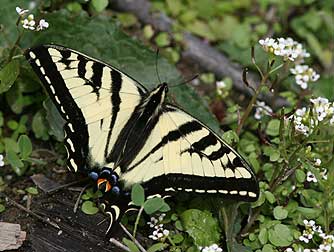On the descent of the hike, I stopped next to a four-foot-high quaking aspen tree alongside the trail. I reached for a leaf, and placed it in my hand. My fingers followed the contours of its outline, amazed at its symmetry. I stepped back to look at the whole tree, when my fiancé said, "Hey, look at this!" Between his fingers he held another aspen leaf. I glanced at the leaf, but didn't notice anything, and looked back at him questioningly. He said, "Look closer." As I stared at the leaf, I was taken aback by the caterpillar that lay on the leaf before me. Two yellow ovals on the top of its head created the appearance of eyes, and a yellow and brown line across its thorax unveiled a smirk (depending on your perspective). Its green body with subtle blue dots blended in perfectly with the leaf.
I learned that this caterpillar was a Western Tiger Swallowtail, or Papilio rutulus, and that it is common to western North America. They are often seen in woodlands, riparian areas, and urban settings. These caterpillars feed on the leaves of hardwoods, such as poplar, willow, alder, maple, cottonwood, and quaking aspen. The Western Tiger Swallowtail caterpillar, or larva, will molt about five times before pupating (that is, evolving from a caterpillar to an adult insect--in this case, a butterfly). For butterflies, the pupal stage is called chrysalis. When the caterpillar has reached its full size, it produces silk to adhere itself to a leaf or limb of a tree. At this point in the process, the caterpillar will shed its skin one last time, leaving a hard skin, called a chrysalis. The caterpillar will stay in this stage until it is ready to turn into a butterfly.
In the summer, a butterfly can emerge within fifteen days of pupating, but if it pupates in the fall, it must wait until springtime, when the temperature begins to rise. The beautiful butterfly that emerges from the chrysalis has yellow on its forewings, a thick black border along the wings' outside edge, and a hint of orange and blue on its tail. Its wingspan is ~8.5 centimeters. Females will lay up to 100 eggs onto the protective underside of leaves, and within four days or so, they will hatch, introducing a new group of smirking caterpillars into the natural world.


